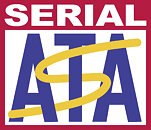Wednesday, July 15th 2020
SATA-IO Increases Interoperability Features with Revision 3.5 Specification
The Serial ATA International Organization (SATA-IO), the storage industry consortium dedicated to sustaining the quality, integrity and dissemination of the Serial ATA (SATA ) technology, today announced the publication of the SATA Revision 3.5 Specification. Specification 3.5 introduces features that enable increased performance benefits and promote greater integration of SATA devices and products with other industry I/O standards.
"SATA-IO has a long tradition of participating in the industry and supporting new innovative technology. These new features underscore the versatility of the SATA standard," said Jim Hatfield, SATA-IO president. "SATA remains one of the most stable, yet adaptable, interfaces in the industry. We are pleased to be able to enhance SATA's compatibility benefits for our members and the industry by adding features which allow SATA and other I/O standards to coexist in a variety of environments."As storage technologies continue to advance, the industry continues to demand improvements in performance, reliability and compatibility. To ensure that members and the industry continue to have a reliable storage solution, the SATA-IO has added new features to the ubiquitous specification that offer improvements in a number of areas including:
The specification is available to SATA-IO members for free, while non-members can purchase the specification by visiting this page.
"SATA-IO has a long tradition of participating in the industry and supporting new innovative technology. These new features underscore the versatility of the SATA standard," said Jim Hatfield, SATA-IO president. "SATA remains one of the most stable, yet adaptable, interfaces in the industry. We are pleased to be able to enhance SATA's compatibility benefits for our members and the industry by adding features which allow SATA and other I/O standards to coexist in a variety of environments."As storage technologies continue to advance, the industry continues to demand improvements in performance, reliability and compatibility. To ensure that members and the industry continue to have a reliable storage solution, the SATA-IO has added new features to the ubiquitous specification that offer improvements in a number of areas including:
- Device Transmit Emphasis for Gen 3 PHY: aligns SATA with other characteristics of other I/O measurement solutions to help SATA-IO members with testing and integration.
- Defined Ordered NCQ Commands: allows the host to specify the processing relationships among queued commands and sets the order in which commands are processed in the queue.
- Command Duration Limit Features: reduces latency by allowing the host to define quality of service categories, giving the host more granularity in controlling command properties. The feature helps align SATA with the "Fast Fail" requirements established by the Open Compute Project (OCP) and specified in the INCITS T13 Technical Committee standard.
The specification is available to SATA-IO members for free, while non-members can purchase the specification by visiting this page.

9 Comments on SATA-IO Increases Interoperability Features with Revision 3.5 Specification
Short version is the connector is tapped out.
On the other hand, NVME only offers benefits in certain workloads where the large speed advantage is plus, but S-ata can still cope and still be just as fast as your latest NVME drive.
S-ata needs to step up it's game.
the cost and changes necessary to duplicate SATA speeds were not trivial nor backwards compatible thus it was decided to EOL SATA at 6gbps and focus on nvme.
and yes, nvme is hardly necessary nor notable for the vast majority of users that would never even notice the difference, but it's the future (conversely, a single lane of pcie is faster than SATA, thus "cheap" nvme drives are starting to appear more and more) and we'll reap the benefits.
sata hotplug is a very very very small niche, nvme/pcie is hotplug but requires different form factor (U.2 like enterprise SSD drives that are contained within a case and have edge connectors designed for hotswapping), not for the consumer m2 drives on bare board
It's so ridiculous that if I want to plug on a desktop 8 drives I have to use 8 physical SATA cables, instead just 2 like SAS.
SATA irrelevancy is perfectly illustrated when you look at NVMe QLC drives which cost the same (or less) and just as well work as media storage for movies, games or other rarely moved stuff. So weird SATA is still around in its archaic form from 2008 (small tweaks here and there don't change the underlying inferiority of the standard compared to SAS and NVMe).
Those changes most likely can be implemented on software/FW alone.
the thing is that the PHY change needs new silicon, so forget we'll see anything anytime soon, most likely we'll see it in enterprise sata hdd and ssd and sas switches/controllers